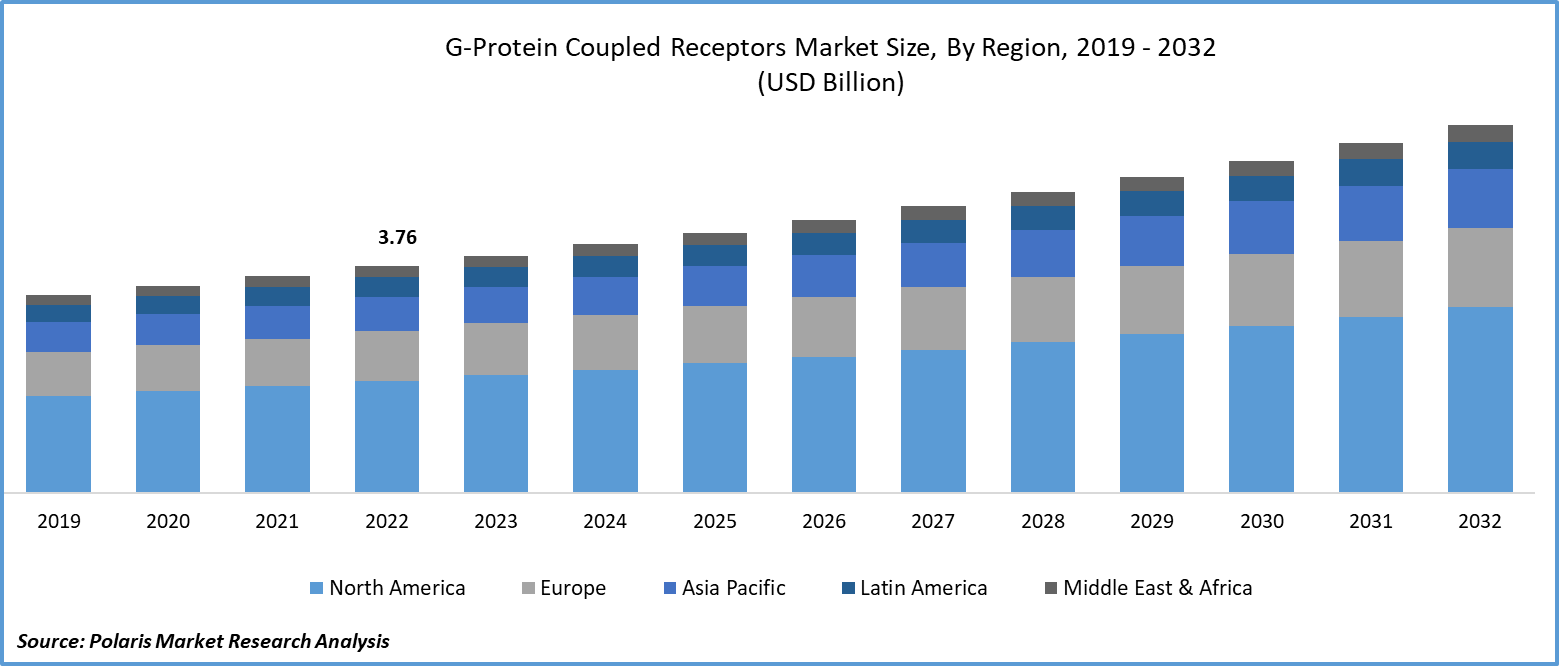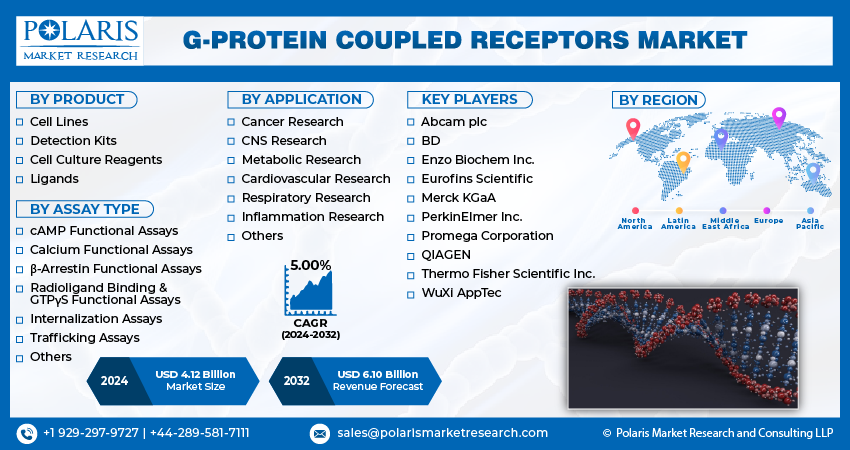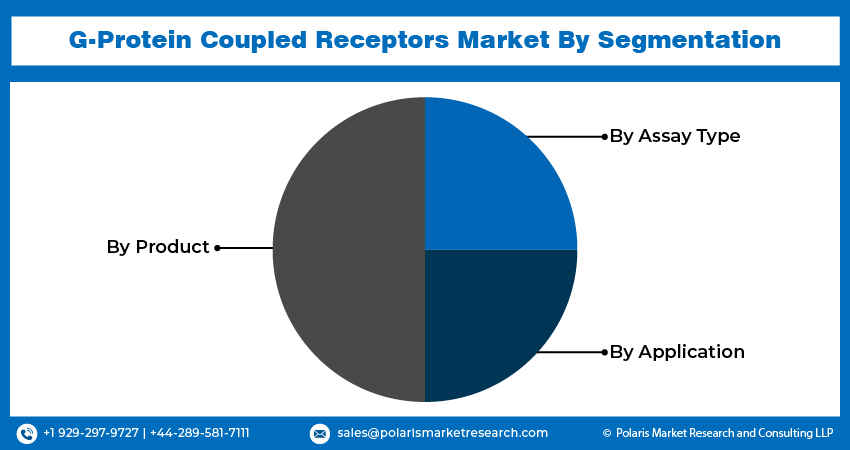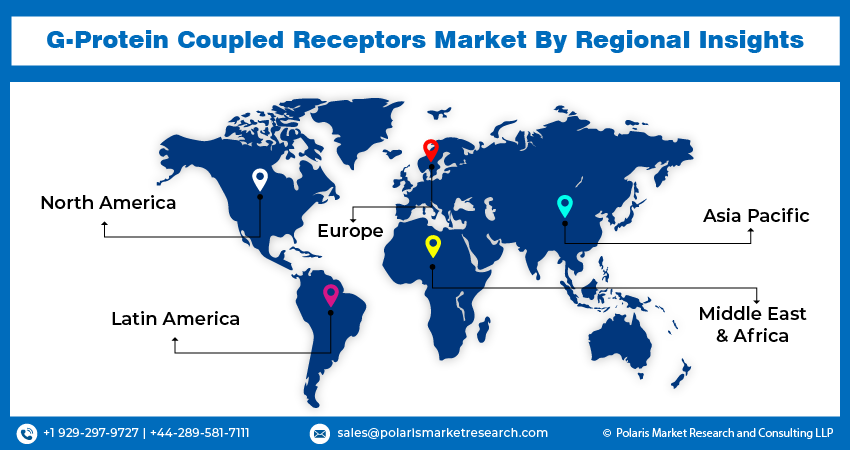
G-Protein Coupled Receptors Market Size, Share, Trends, Industry Analysis Report
: By Product (Cell Lines, Detection Kits, Cell Culture Reagents, and Ligands), By Assay Type, By Application, and By Region – Market Forecast, 2025–2034
- Published Date:Aug-2025
- Pages: 129
- Format: PDF
- Report ID: PM4093
- Base Year: 2024
- Historical Data: 2020-2023
Market Overview
The global G-protein coupled receptors (GPCR) market size was valued at USD 3,886.23 million in 2024, at a CAGR of 6.02% during 2025–2034. The market is growing due to increasing investment in research, advancements in drug discovery technologies, and rising demand for targeted therapies driven by chronic diseases and personalized medicine.
Key Insights
- The cell lines segment leads the GPCR market due to their consistent and reproducible models for studying GPCR function and drug screening.
- cAMP functional assays are expected to grow rapidly, offering sensitive and quantitative data for receptor function and drug discovery.
- North America dominates the market due to strong research infrastructure, high investment in drug discovery, and the presence of leading pharmaceutical companies.
- Asia Pacific is projected to grow the fastest due to increasing healthcare investments, expanding pharmaceutical industries, and heightened research activity.
Industry Dynamics
- Rising investments in research and development and government initiatives are driving the growth of the GPCR market.
- Increasing focus on personalized medicine and the shift towards targeted therapies is boosting the demand for GPCR-based solutions.
- The growing prevalence of chronic and lifestyle-related diseases, such as diabetes and cardiovascular disorders, is fueling the market expansion.
- Advancements in drug discovery technologies, such as high-throughput screening and computational modeling, are enhancing the development of GPCR therapeutics.
- Regulatory hurdles, high costs, and the complexity of developing GPCR-targeted drugs could limit the market’s faster growth.
Market Statistics
2024 Market Size: USD 3,886.23 million
2034 Projected Market Size: USD 6,965.93 million
CAGR (2025–2034): 6.02%
North America: Largest market in 2024

To Understand More About this Research: Request a Free Sample Report
G-protein coupled receptors (GPCRs), a large family of cell surface receptors that respond to various external signals, play an essential role in numerous physiological processes and disease mechanisms. The GPCR market is witnessing robust growth, driven by rising investment and supportive government initiatives. In January 2024, St. Jude Children's Research Hospital launched a USD 13 million GPCR research project as part of a USD 160 million initiative to accelerate breakthroughs on these critical cellular receptors and their role in human health and disease. Increasing funding from both private and public sectors is fueling extensive research and development activities aimed at unlocking new therapeutic targets associated with GPCRs. Additionally, government programs promoting innovation in drug discovery are providing a strong foundation for technological advancements in this field, further enhancing the market's potential.
The G-protein coupled receptors industry growth is attributed to the increasing focus on personalized medicine and targeted therapies. GPCRs assay kits market is becoming central to the development of precision therapies tailored to specific patient profiles as healthcare increasingly shifts toward individualized treatment approaches. According to a 2023 IPJR study of 700 patients (mean age 54.2, 68% cancer cases), personalized medicine improved treatment efficacy, with 45% receiving pharmacogenomics-guided therapy and 30% targeted treatments, further reflecting benefits that were seen in oncology and cardiovascular care. The ability of GPCRs to influence diverse biological responses makes them attractive targets for designing highly specific and effective therapeutics. This evolving landscape is encouraging pharmaceutical companies to invest in GPCR-based drug discovery services, supporting the market expansion.
Market Dynamics
Increasing Prevalence of Chronic and Lifestyle-Related Diseases
The increasing prevalence of chronic and lifestyle-related diseases such as diabetes, cardiovascular disorders, and respiratory illnesses is driving the demand for G-protein coupled receptors. A February 2025 Department of Biotechnology report revealed that non-communicable diseases cause 73% of global deaths. In India, they account for 53% of mortality and 44% of disability-adjusted life-years lost, highlighting their growing health burden worldwide. GPCR market is deeply involved in regulating many critical biological pathways, making them valuable targets for therapeutic interventions in these widespread conditions. There is a growing demand for effective targeted therapies that can address complex disease mechanisms as the global burden of chronic diseases continues to rise. This demand is encouraging pharmaceutical and biotechnology companies to strengthen their focus on GPCR-based drug discovery, thereby propelling the demand for G-protein coupled receptors.
Advancements in Drug Discovery Technologies
Advancements in drug discovery technologies are boosting the GPCR market expansion. Innovations such as high-throughput screening, structure-based drug design, and computational modeling have greatly enhanced the ability to identify and optimize GPCR-targeted compounds. In May 2024, Twist Bioscience launched Multiplexed Gene Fragments (MGFs), a synthetic DNA pool of up to 500 BP, enabling cost-effective high-throughput screening for CRISPR, antibody discovery, and protein engineering. The scalable platform offers high uniformity and broad applications for researchers. These technological improvements are enabling researchers to understand receptor behavior better, predict drug efficacy, and reduce the time and cost associated with drug development. As a result, the adoption of advanced drug discovery platforms is strengthening the pipeline of GPCR-targeted therapeutics, further supporting the G-protein coupled receptors market expansion.

Segment Insights
Market Assessment by Product
The global market segmentation, based on product, includes cell lines, detection kits, cell culture reagents, and ligands. The cell lines segment dominated the G-protein coupled receptors market share in 2024, primarily attributed to the critical role of cell lines in providing consistent and reproducible models for studying GPCR function and drug screening. Cell lines offer a reliable platform for high-throughput screening, receptor characterization, and functional analysis, making them indispensable tools in both academic and pharmaceutical research. Their widespread use in preclinical drug development processes further solidifies their strong position within the market.
Market Evaluation by Assay Type
The global market segmentation, based on assay type, includes cAMP functional assays, calcium functional assays, β-arrestin functional assays, radioligand binding & GTPγS functional assays, internalization assays, trafficking assays, and others. The cAMP functional assays segment is expected to witness substantial growth during the forecast period as they are essential for measuring intracellular signaling events triggered by GPCR activation, providing highly sensitive and quantitative data. Their ability to offer real-time insights into receptor function makes them a preferred choice in drug discovery and pharmacological research. The growing adoption of these assays for developing targeted therapies is especially enhancing their demand, driving their rapid expansion within the GPCR market.

Regional Insights
By region, the report provides the GPCR market insights into North America, Europe, Asia Pacific, Latin America, and the Middle East & Africa. North America dominated the market revenue share in 2024, owing to its strong research infrastructure, high investment in drug discovery, and presence of pharmaceutical and biotechnology companies. In April 2025, Novartis announced to invest USD 23 million over five years to expand US manufacturing and R&D, adding 10 facilities (7 new). The expansion enables complete domestic production of key medicines and establishes a San Diego research hub. The region benefits from a robust network of academic institutions and research organizations that actively engage in GPCR research. Moreover, supportive regulatory frameworks and substantial funding for innovative healthcare solutions have further accelerated the development and commercialization of GPCR-targeted therapeutics in North America.
The Asia Pacific G-protein coupled receptors market is projected to witness the fastest growth during the forecast period, driven by rising healthcare investments, expanding pharmaceutical industries, and increasing focus on research and development activities. According to a March 2025 report from India's Ministry of Commerce and Industry, the country's healthcare and pharmaceutical sector received investments totaling USD 30 million during 2022–2024. Countries such as China, India, and Japan are rapidly enhancing their biotechnological capabilities and research infrastructure. Additionally, growing awareness of advanced therapies and a surge in the prevalence of chronic diseases are creating new opportunities for GPCR-based research and therapeutics across Asia Pacific.

Key Players and Competitive Analysis
The GPCR market landscape is dominated by pharmaceutical companies such as Pfizer, Novartis, and Merck, who collectively control the market revenue share. However, emerging biotechnology firms such as Sosei Heptares and Confo Therapeutics are rapidly gaining ground through innovative technology platforms and strategic alliances with larger companies. Competition is boosting oncology and neurological applications, where latent demand and opportunities remain substantial. Major strategic developments include the adoption of AI-driven drug discovery platforms and cryo-EM technology for structural determination, accelerating development timelines. Regional footprint analysis reveals North America maintaining leadership in global revenue, though Asia Pacific demonstrates the highest growth projections through 2030. Industry-leading competitive intelligence indicates that companies investing in allosterically-targeted compounds are positioning advantageously against traditional orthostatic approaches. The internationalization behavior of mid-sized players reveals an increased focus on and emerging economies for clinical trials. A few key major players are Abcam plc, Cisbio (Revvity), Confo Therapeutics, DiscoverX (Eurofins), Eurofins Scientific, Heptares Therapeutics (Sosei Group), Merck KGaA, Molecular Devices, PerkinElmer Inc., Promega Corporation, Sartorius (BellBrook Labs), Tango Biosciences, Thermo Fisher Scientific Inc., WuXi AppTec, and Alomone Labs.
Abcam plc, a UK-based global life sciences company, is recognized for its contributions to the G-protein coupled receptors (GPCR) field, providing high-quality biological reagents, antibodies, and assay tools that are essential for GPCR research, drug discovery, and diagnostics. Abcam supports scientists worldwide by offering validated antibodies, premium-grade bioactive proteins, and custom protein production services tailored to the needs of cell culture, regenerative medicine, and therapeutic development with a portfolio of over 110,000 products. The company’s expertise in producing proteins with native conformations and post-translational modifications ensures optimal bioactivity and batch-to-batch consistency, which is critical for reliable GPCR studies and drug screening applications. Abcam’s innovative approach includes co-creating novel binders with life science organizations, leveraging proprietary discovery platforms and advanced validation technologies. The company’s commitment to data transparency, peer-reviewed validation, and global customer support has positioned it as a trusted partner in advancing the understanding of GPCR biology and accelerating the development of targeted therapies.
Eurofins Scientific is an international life sciences group headquartered in Luxembourg, renowned for its comprehensive analytical testing services across the pharmaceutical, food, environmental, and biopharma sectors. Eurofins offers a portfolio exceeding 200,000 validated analytical methods, supporting clients in product safety, identity, purity, and authenticity assessments with a network of over 900 laboratories in more than 60 countries. In the G-protein coupled receptors (GPCRs) industry, Eurofins is recognized for its discovery pharmacology and biopharma contract research services, providing specialized testing and laboratory solutions that are integral to GPCR research and drug development. The company’s expertise in genomics, molecular biology, and advanced material sciences enables the development and validation of assays essential for understanding GPCR function, ligand screening, and signaling pathway analysis. Eurofin’s services are widely utilized by pharmaceutical and biotechnology companies seeking to accelerate GPCR-targeted drug discovery, optimize lead compounds, and ensure regulatory compliance.
List of Key Companies
- Alomone Labs
- Abcam plc
- Cisbio (Revvity)
- Confo Therapeutics
- DiscoverX (Eurofins)
- Eurofins Scientific
- Heptares Therapeutics (Sosei Group)
- Merck KGaA
- Molecular Devices
- PerkinElmer Inc.
- Promega Corporation
- Sartorius (BellBrook Labs)
- Tango Biosciences
- Thermo Fisher Scientific Inc.
- WuXi AppTec
G-Protein Coupled Receptors Industry Developments
November 2024: Nxera Pharma (formerly Sosei Heptares) collaborated with AI-driven Antiverse to develop GPCR-targeting antibodies. Combining Nxera’s GPCR expertise with Antiverse’s AI platform, the collaboration aims to create agonistic antibodies for high-need diseases.
August 2024: Ono Pharmaceutical expanded its GPCR antibody collaboration with Monash University to target new receptors for autoimmune/inflammatory diseases. Ono gains exclusive global rights to develop selected antibodies, with milestone/royalty payments contingent on success.
July 2024: Confo Therapeutics secured USD 65 million in Series B funding to advance four GPCR-targeting programs, including GPR75 for obesity. The financing will support Phase 1 trials and IND approvals for small molecules and agonistic antibodies.
G-Protein Coupled Receptors Market Segmentation
By Product Outlook (Revenue, USD Million, 2020–2034)
- Cell Lines
- Detection Kits
- Cell Culture Reagents
- Ligands
By Assay Type Outlook (Revenue, USD Million, 2020–2034)
- cAMP Functional Assays
- Calcium Functional Assays
- β-Arrestin Functional Assays
- Radioligand Binding & GTPγS Functional Assays
- Internalization Assays
- Trafficking Assays
- Others
By Application Outlook (Revenue, USD Million, 2020–2034)
- Cancer Research
- CNS Research
- Metabolic Research
- Cardiovascular Research
- Respiratory Research
- Inflammation Research
- Others
By Regional Outlook (Revenue, USD Million, 2020–2034)
- North America
- US
- Canada
- Europe
- Germany
- France
- UK
- Italy
- Spain
- Netherlands
- Russia
- Rest of Europe
- Asia Pacific
- China
- Japan
- India
- Malaysia
- South Korea
- Indonesia
- Australia
- Vietnam
- Rest of Asia Pacific
- Middle East & Africa
- Saudi Arabia
- UAE
- Israel
- South Africa
- Rest of Middle East & Africa
- Latin America
- Mexico
- Brazil
- Argentina
- Rest of Latin America
G-Protein Coupled Receptors Market Report Scope
|
Report Attributes |
Details |
|
Market Size Value in 2024 |
USD 3,886.23 million |
|
Market Size Value in 2025 |
USD 4,114.90 million |
|
Revenue Forecast in 2034 |
USD 6,965.93 million |
|
CAGR |
6.02% from 2025 to 2034 |
|
Base Year |
2024 |
|
Historical Data |
2020–2023 |
|
Forecast Period |
2025–2034 |
|
Quantitative Units |
Revenue in USD Million and CAGR from 2025 to 2034 |
|
Report Coverage |
Revenue Forecast, Competitive Landscape, Growth Factors, and Industry Trends |
|
Segments Covered |
|
|
Regional Scope |
|
|
Competitive Landscape |
|
|
Report Format |
|
|
Customization |
Report customization as per your requirements with respect to countries, regions, and segmentation. |
FAQ's
The global market size was valued at USD 3,886.23 million in 2024 and is projected to grow to USD 6,965.93 million by 2034.
The global market is projected to register a CAGR of 6.02% during the forecast period.
North America dominated the market share in 2024.
A few of the key players in the market are Abcam plc, Cisbio (Revvity), Confo Therapeutics, DiscoverX (Eurofins), Eurofins Scientific, Heptares Therapeutics (Sosei Group), Merck KGaA, Molecular Devices, PerkinElmer Inc., Promega Corporation, Sartorius (BellBrook Labs), Tango Biosciences, Thermo Fisher Scientific Inc., WuXi AppTec, and Alomone Labs.
The cell lines segment dominated the market share in 2024.
The cAMP functional assays segment is expected to witness substantial growth during the forecast period.
G-Protein Coupled Receptors (GPCRs) are a large family of cell surface receptors that play a crucial role in cellular communication and signal transduction. These receptors are involved in transmitting signals from outside the cell to the inside, allowing cells to respond to a variety of external stimuli, such as hormones, neurotransmitters, and sensory signals like light and smell. GPCRs are activated by binding to specific molecules (ligands), which then activate internal signaling pathways via G-proteins, a type of intracellular protein. GPCRs are involved in a wide range of physiological processes, including vision, taste, smell, immune response, and the regulation of heart rate and blood pressure. Given their central role in many biological functions, they are important targets in drug discovery, especially for treating conditions such as cardiovascular diseases, neurological disorders, and cancer. The versatility and wide-ranging impact of GPCRs make them essential components in both basic research and therapeutic development.
